Peloponnisos: A Journey through History and Time
Greece’s southernmost peninsula looks small on the map, yet it holds within it much of the country’s vast history and culture. Ancient sites include the Homeric palaces of Agamemnon at Mycenae and of Nestor at Pylos, the best preserved of all Greek theatres at Epidaurus, and the historic sanctuary of Olympia, host to the Olympic Games for a millennium. The medieval remains are no less rich, with the fabulous Venetian, Frankish and Turkish castles of Nafplio, Methoni and Corinth, the proud battle towers and frescoed churches of Mani and the extraordinarily well-preserved Byzantine cities of Mystra and Monemvasia.
Let’s take a look at each of the seven prefectures and their main attractions.
Corinthia
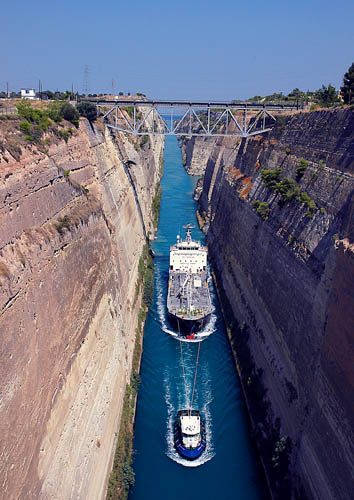
Corinth canal (credit: travelgreece.com)
A thin strip of land, about 6,5 kilometers wide, was all that connected the peninsula with the mainland for thousands of years, until 1893, the year the Corinthian Canal was officially opened.
Seeing tankers and cruisers pass through the narrow canal is always a unique sight and the best way to begin your trip through Peloponnisos.
Once one of the most powerful cities of the Classical world, Ancient Corinth came under Roman rule in 146 BC. It is here that St. Paul preached to the people of Corinth in AD 51-52, and his experience later inspired him to write the New Testament books of the First Corinthians and Second Corinthians, among the most quoted books of the Bible. Today, amid the archaeological excavations, you can see the ruins of various buildings including temples, a forum, baths, and a basilica.
A few kilometers south of Ancient Corinth lies the famous Temple of Apollo, a UNESCO World Heritage Site. The ascent to the top of this impressive fortified hilltop (575 meters) is made easier by a road, which climbs to a point near the lowest gate on the west side. Acrocorinth was fortified in ancient times, and its defences were maintained and developed during the Byzantine, Frankish, Turkish, and Venetian periods, so that its walls now measure almost two kilometers in length. Within the fortress, a path leads to the highest point, to the former Temple of Aphrodite, which was converted into a mosque by the Ottoman Turks in the 16th century. From here, there are fine views of the Isthmus and the hills of the Peloponnese.
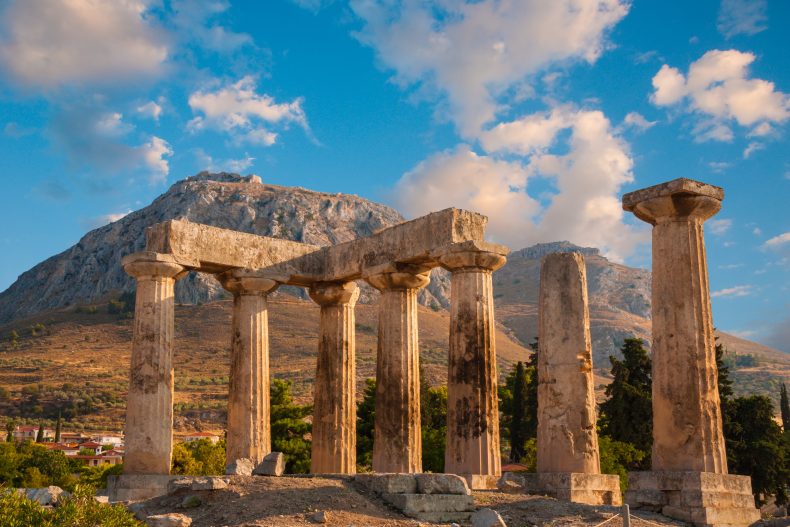
Temple of Apollo (credit: travelgreece.com)
Achaia
Featuring Patras, the biggest of the cities of the Peloponnese and third largest city in Greece, Achaia is filled with exceptional mountain and seaside landscapes. It boasts the Panachaiko, Helmos and Erymanthos mountains, not to mention the most beautiful sandy beaches in the Corinthian Gulf. On the road to Patras, the iconic Rio-Antirrio Bridge is hard to miss. Achaia is one of the most historic sites in the Peloponnese and Greece’s seaside gate to Western Europe.
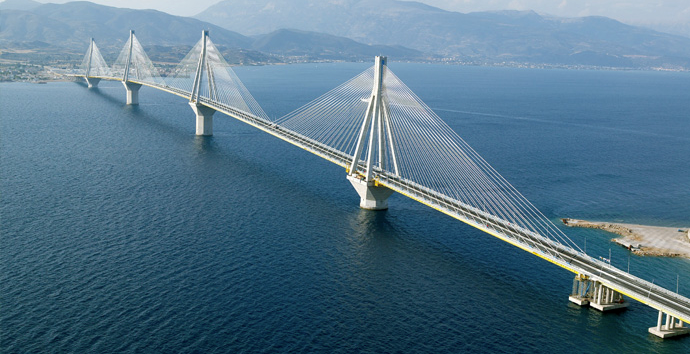
Rio-Antirio bridge (credit: travelgreece.com)
Ilia
Ilia is best known as the home of Ancient Olympia and the Temple of Epicurean Apollo, both World Heritage Sites that attract many tourists. For many centuries, Ancient Olympia was the site for the Olympic Games and today is used for the torch-lighting ceremony before every modern game.
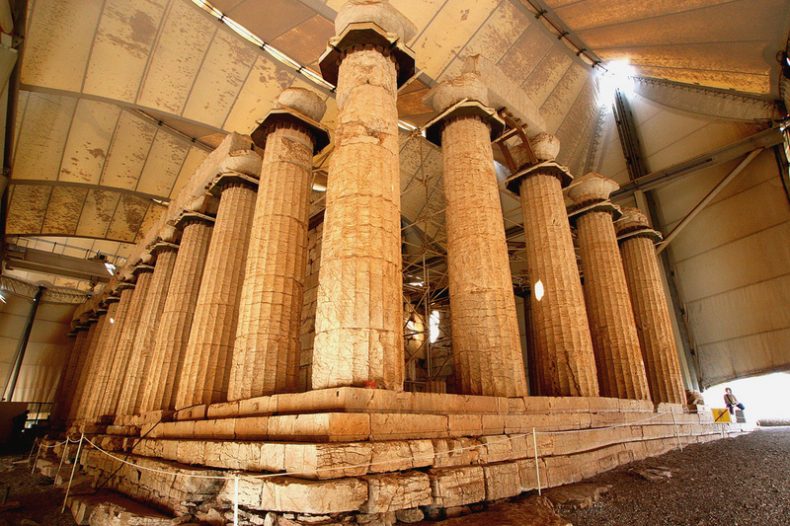
Temple of Epicurean Apollo (credit: travelgreece.com)
Messinia
The natural beauty of Messinia with the indented shores, sandy beaches, forested mountains and fertile valleys, coexists with significant archaeological monuments. People have lived in Messiniasince the Neolithic age; however the Mycenaean age was indisputably the golden age in Messenia’s history, when Pylos was the second largest city after Mycenae. On 20th October 1827, the allied fleet fought at Navarino bay, against the combined Turkish and Egyptian fleet, an event which essentially signaled the independence of the Peloponnese from Ottoman rule. The beach of Voidokoilia is a stunning natural wonder that should not be missed.
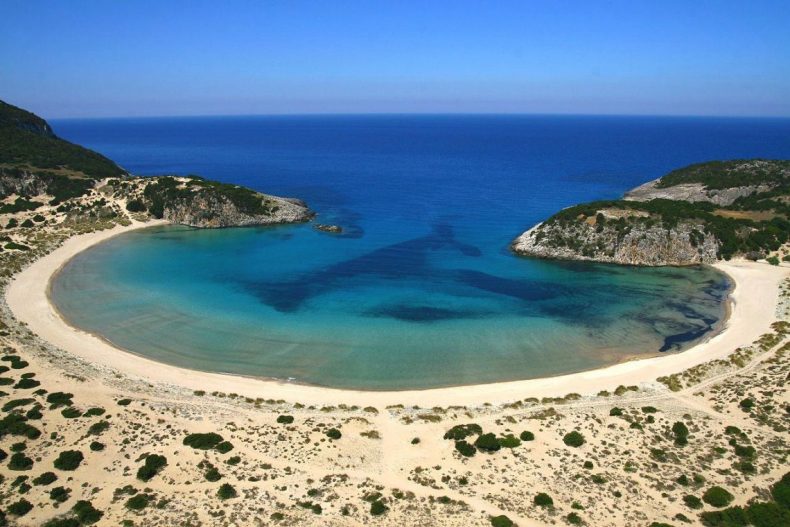
Voidokoilia beach (credit: travelgreece.com)
Laconia
Laconia is a significant tourist destination, which combines famous sites, such as medieval Mystra, the fortress city at Monemvasia, and the tower houses in Mani, with locations of exceptional natural beauty, such as the Diros caves, Mt. Taygetos and cape Tainaros.
Laconia has been inhabited since the Palaeolithic and Neolithic years, while it was later settled by the Leleges, Achaeans and Ionians. The Dorians arrived in 1100 B.C. and made Sparta their capital, which for centuries together with Athens, was one of the most powerful city-states in Ancient Greece.
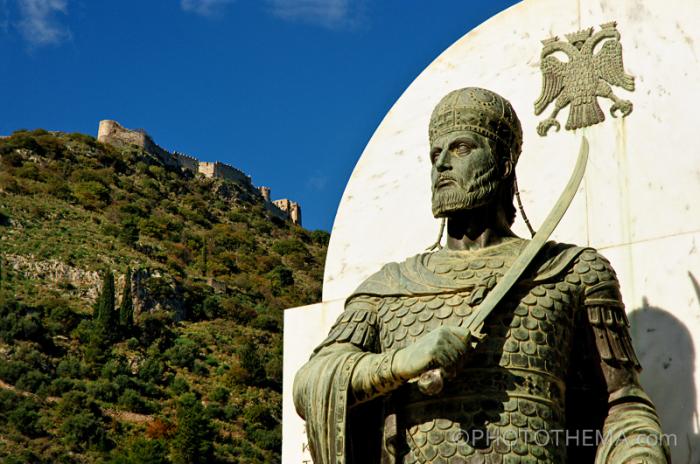
Mystras (credit: travelgreece.com)
Arcadia
The heartland province of the Peloponnese contains some of the most beautiful landscapes in Greece. Dramatic hills are crowned by a string of medieval towns in a lush meadow, the beauty of which has made the word “arcadia” synonymous to “pastoral paradise”. Beautiful Karitena is a picture-postcard hill town, but the best area of all is around Stemnítsa and Dimitsana, where hikers are rewarded with the luxuriant Lousios Gorge. Another hill town, Andhritsena, attracts archeology buffs with the nearby Temple of Bassae.
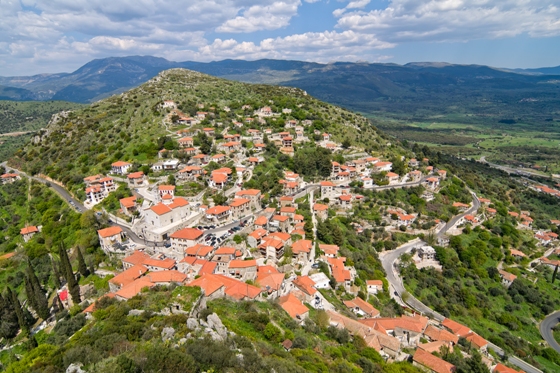
Karytaina (credit: travelgreece.com)
Argolida
The tour of Peloponnisos ends with Argolida, the “thumb” of the peninsula, which includes the beautiful city of Nafplion and the important archaeological site of Mycenae.
Nafplio is a lively, beautifully sited place that exudes a grand elegance inherited from the days when it was the first capital of modern Greece. The town is a popular year-round weekend retreat and remains by far the most attractive base for exploring Argolida. Palamidi, Náfplio’s principal fort, was a key military flashpoint of the War of Independence. The Greek commander Kolokotronis laid siege for over a year before finally gaining control. After independence, he was imprisoned in the same fortress by the new Greek government; wary of their attempts to curtail his powers, he had kidnapped four members of the parliament. Akronafplia fort, to the west of Palamidi, occupies the ancient acropolis, whose walls were adapted by three successive medieval restorers. The fortifications are today far less complete than those of the Palamídhi, and the most intact section, the lower Torrione castle, was adapted to house hotels. The town’s third fort, the much-photographed Bourtzi, occupies Agiou Theodorou islet offshore from the harbour. Built in 1473 by the Venetians to control the shipping lane to the town, the castle has seen various uses in modern times – from the nineteenth-century home of the town’s public executioner to a luxury hotel in the early twentieth century. In her autobiography I Was Born Greek, the actress and politician Melina Mercouri claimed to have consummated her first marriage there.
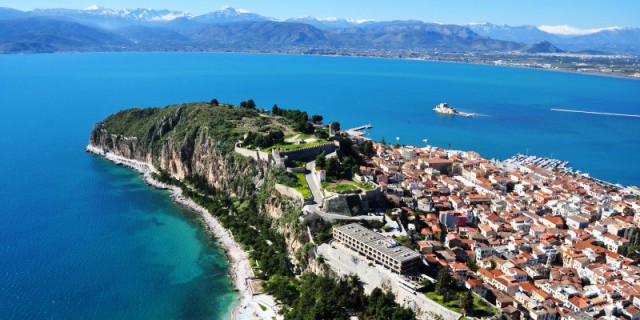
Nafplio (credit: travelgreece.com)
Tucked into a fold of the hills just east of the road from Corinth to Árgos, Agamemnon’s citadel at Mycenae fits the legend better than any other place in Greece. It was uncovered in 1874 by the German archeologist Heinrich Schliemann (who also excavated the site of Troy), impelled by his single-minded belief that there was a factual basis to Homer’s epics. Schliemann’s finds of brilliantly crafted gold and sophisticated tomb architecture bore out the accuracy of Homer’s epithets of “well-built Mycenae, rich in gold”. And with the accompaniment of the sound of bells drifting down from goats grazing on the hillsides, a stroll around the ramparts is still evocative of earlier times.
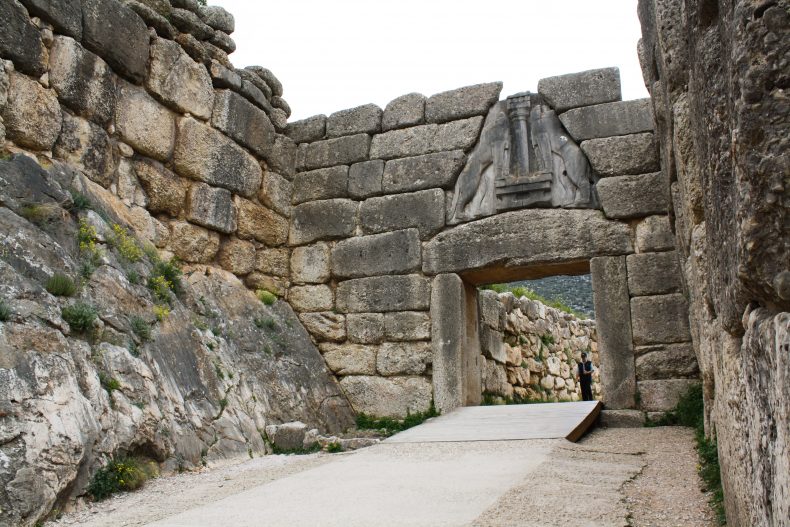
Mycenae (credit: travelgreece.com)
The Citadel of Mycenae is entered through the famous Lion Gate, whose huge sloping gateposts bolster walls dubbed “Cyclopean” by later Greeks, in bewildered attribution to the only beings deemed capable of their construction. Above them a graceful carved relief stands out in confident assertion: Mycenae at its height led a confederation of Argolid towns (Tiryns, Árgos, Assine, Hermione – present-day Ermioni), dominated the Peloponnese and exerted influence throughout the Aegean. The motif of a pillar supported by two muscular lions was probably the symbol of the Mycenaean royal house, for a seal found on the site bears a similar device.
Peloponnisos is a perfect year-round destination that caters to all tastes. Let Hellenic Holidays help you create the perfect holiday package for you to explore every corner of this fascinating corner of Greece.
